RBSE Solutions for Class 7 Science Chapter 7 Organic Evolution are part of RBSE Solutions for Class 7 Science. Here we have given Rajasthan Board RBSE Class 7 Science Chapter 7 Organic Evolution.
| Board | RBSE |
| Textbook | SIERT, Rajasthan |
| Class | Class 7 |
| Subject | Science |
| Chapter | Chapter 7 |
| Chapter Name | Organic Evolution |
| Number of Questions Solved | 49 |
| Category | RBSE Solutions |
Rajasthan Board RBSE Class 7 Science Chapter 7 Organic Evolution
Textbook Exercise
Multiple Choice Questions
Choose the correct option
Question 1.
Heart of fish has
(a) One auricle one ventricle
(b) One auricle two ventricles
(c) Two auricles one ventricle
(d) Two auricles two ventricle
Answer:
(a) One auricle one ventricle
Question 2.
Archaeopteryx is a connecting link between
(a) Pisces and amphibian
(b) Reptiles and Aves
(c) Aves and mammals
(d) Amphibians and reptiles
Answer:
(b) Reptiles and Aves
Question 3.
Which Scientist gave a theory of mutation
(a) Lamarck
(b) Darwin
(c) Hugo de Vries
(d) Mendel
Answer:
(c) Hugo de Vries
Question 4.
Forelimb of whale is called as
(a) Flipper
(b) arm
(c) wing
(d) leg
Answer:
(a) Flipper
Fill in the blanks
1. Wings of bird and bat are …………. organ.
2. Vertebral Column is consists of small …………..
3. Every organisms, in its development, repeat its ……………. history.
4. Organic evolution is a ……………… and process.
5. Darwin gave Theory of ……………
Answer:
1. Analogous
2. Vertebrae
3. Organic
4. slow, gradual
5. Natural selection
Short Answer Type Questions
Question 1.
Write differences between homologous and analogous organs.
Answer:
| Homologous organs | Analogous organs |
| Organs of different animals which have similar basic structure and origin. | Organs which have different basic structure and origin. |
| They have different functions. | They have same functions. |
Question 2.
Write the process of fossils formation.
Answer:
The dead body of organisms were buried under rocks especially sedimentary rocks. As the time passes, their remains are left in these rocks. These are known as fossils. Some times, whole body of organisms changes into fossils.
Question 3.
Draw a structure of hearts of different animals to show sequence of organic evolution.
Answer:
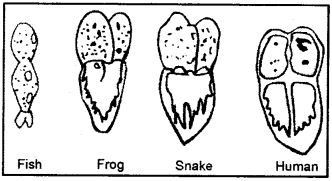
Question 4.
Define Lamarck’s Theory of evolution with examples.
Answer:
According to Lamarck, the organs which are frequently used were developed more whereas the organs which were used less frequently perish. For example, as a result of more use of neck and fore limbs of African giraffe, these organs increase in size.
Question 5.
What is mutation?
Answer:
In some organisms, suddenly some changes take place. These changes transfer from one generation to another. These sudden changes in an organism which transfer from one generation to another are called mutations.
Long Answer Type Questions
Question 1.
Explain evolution on the basis of evidences of embryology.
Answer:
Evidences from Embryology: In multicellular organisms, zygote is formed as a result of sexual reproduction.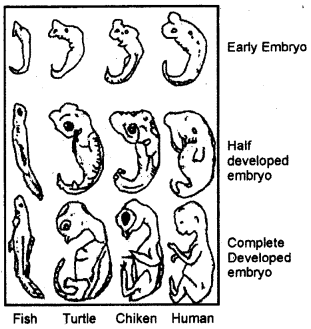
When we see fish, turtle,chicken, human’s embryo, early stages of them appears almost identical. This proves that the ancestors of all vertebrates resemble with fish and their development is certainly in order. Every organisms in its development repeats its organic history called as Theory of Recapitulation. This theory was proposed by German Scientist Haeckel.
Question 2.
Clarify different steps of Darwin’s Theory.
Answer:
Charles Robert Darwin’s gave a theory of natural selection for organic evolution. Different phases of Darwin’s theory are as under:
1. Production of off spring in living organisms: Each organism does production of off springs to maintain their race. Example, elephant produces 8 off springs in her life span. It is a slow breeder. A pair of elephant began to breed regularly and engender that all off springs are regularly breeding in the 750 years a pair will generate approximately 1.9 million elephants and number of elephants will be very high. But this does not happen.
2. The struggle for survival: Due to over production of off springs, the struggle for space and food for the growing number of offspring takes place. It is the struggle of survival. This struggle occurs in between animals of own species; and with other species also which is capable of the same shall live. Destruction due to struggle, the number of organisms will remains balanced and consistence in nature.
3. Natural Selection: In struggle of survival only those animals live who adapt them according to nature. If they are not able to do it, then they are destroyed.
4. Origin of new species: Inheritance of useful traits will continue from generation to generation and harmful traits gradually become extinct or remains as Vestigial organ. Sometimes, variations increase so that after new generation is more different from older generation and development of a new race goes. For example, at the beginning dog, jackal and wolves, three were members of the same race but due to change in atmosphere to adapt themselves accordingly, changes in their size and physical characteristics occurred, After thousands of years dog, fox and wolf, three new species were developed.
Question 3.
Explain a process of formation of fossils.
Answer:
Process of formation of fossils: Fossils are formed in a number of different ways, but most are formed when a plant or animal dies in a watery environment and is buried in mud and silt. Soft tissues quickly decompose leaving the hard bones or shells behind. Over time sediment builds over the top and hardens into rock. Not all animals are converted into fossils, only those can be converted which died at a place where they can be preserved.
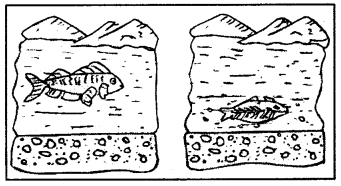
Intext Questions
Question 1.
When and how did life begin? (Page 63)
Answer:
Life originated on Earth about 3.5 billion years ago. Life originated as a result of very slow and gradual process. Initially, the atmosphere of earth was reducing. The conditions favorable for life were there at that time which are not present now. Some amino acids were formed as a result of some chemical reactions. Primary simple cell is formed by some combination of amino acids which gave rise to different individuals.
Question 2.
What were all the creatures from beginning same as they are today? (Page 63)
Answer:
No, all organisms were not the same as they are today. A lot of variations takes place from the very past till now and this gave rise to new species
Activity
Question 1.
Make a chart of organic evolution and fix in a class room.
Answer:
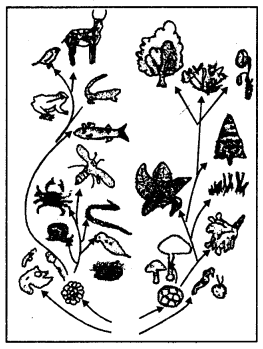
Question 2.
Make a collage of vestigial organs.
Answer:
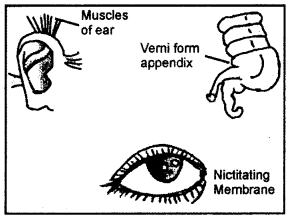
Other Important Questions
Multiple Choice Questions
Question 1.
Most developed group is
(a) Pisces
(b) Aves
(c) Reptiles
(d) Mammals
Answer:
(d) Mammals
Question 2.
Which of the following is a pair of homologous organs?
(a) wings of bird – hands of man.
(b) wings of bat – wings of insects
(c) Wings of birds – wings of insects
(d) Flippers of whales – fins of fish
Answer:
(a) wings of bird – hands of man.
Question 3.
Which ofthe following is a pair of analogous organs?
(a) Wings of birds – wings of insects
(b) Hands of man – forelimb of horse
(c) Flippers of whales – wings of bat
(d) Wings of birds – flippers of whales
Answer:
(a) Wings of birds – wings of insects
Question 4.
The solid evidence of evolution is
(a) Vestigial organs
(b) Fossils
(c) Organic evolution
(d) Embryology
Answer:
(b) Fossils
Question 5.
Theory of Mutation was given by:
(a) Lamarck
(b) Darwin
(c) Hugo de Vries
(d) Heckle
Answer:
(c) Hugo de Vries
Question 6.
The principle oflnheritance of Acquired traits was given by:
(a) Darwin
(b) Lamarck
(c) Birbal Sahni
(d) Hugo de Vries
Answer:
(b) Lamarck
Fill in the Blanks
1. Pisces gave rise to ………………. group.
2. The remains of dead organisms found on rocks are called …………………
3. Generally, ……………….. is found in Vertebrates.
4. Giraffe is found only in …………….
5. ……………. gave Theory of Mutation.
Answer:
1. Reptiles
2. Fossils
3. Skeleton
4. Africa
5. Hugo de Vries
Very Short Answer Type Questions
Question 1.
How primitive protein formation took place on earth?
Answer:
The formation ofprimitive protein occurred as a result of chemical reaction between amino acids and carboxylic acid.
Question 2.
Explain Organic Evolution.
Answer:
Organic evolution refers to the slow and gradual process by which living organisms have changed from the simplest unicellular form to the most complex multi-cellular forms that are existing today.
Question 3.
Which type of organisms develop first on earth?
Answer:
Initially, unicellular organisms developed on Earth.
Question 4.
Write the name of one extinct animal.
Answer:
Dinosaur.
Question 5.
Write the name of two vestigial organs.
Answer:
- Tonsils
- Appendix.
Question 6.
What is the similarity between fish and a man on the basis of skeleton.
Answer:
In both of them, skeleton is made up of vertebrae.
Question 7.
What is the difference between fish and frog?
Answer:
Heart of a fish has two valves where as heart of a frog has three valves.
Question 8.
What is the basis of classification?
Answer:
In classification, the organisms having same characteristics are put in same group.
Question 9.
Write the name of one fossil.
Answer:
Archaeopteryx.
Question 10.
Write the name of an Indian PaleoBotanist?
Answer:
Professor Birbal Sahni.
Short Answer Type questions
Question 1 .
Write a short note on Organic evolution.
Answer:
On earth, firstly single celled organisms were formed. Then multicellular organisms were originated from them. Earlier, these were simple, but in gradual development became complicated. All animals were initially without a back bone. Fishes grew from them, by which amphibians were developed. From these evolved reptiles who ruled on the earth millions of years. Thereafter, some reptiles developed into birds and other in mammals. Animals from one class to another takes thousands of years to develop. Similarly, the evolution in plants also take place.
Question 2.
What are homologous organs? How do they prove organic evolution?
Answer:
Homologous organs maybe defined as the organs of different animals which have similar basic structure but different functions. For example, hands of man and wings of birds have different functions but their basic structure and origin is same. There are different organisms at different levejs which shows similarity in their structures. These also gives evidence for organic evolution.
Question 3.
Tabulate the function of forelimbs of some animals and their transformation.
Answer:
| S.No. | Name of animal | Function of forelimbs | Transformation into |
| 1 | Whale | Swimming | flippers |
| 2 | Birds | Flying | wings |
| 3 | Bat | Flying | wings |
| 4 | Man | Holding things | hands |
Question 4.
What are Analogous organs? Which fact is proved by these organs?
Answer:
The wings of insects, bird.bat etc., help them in flying. There are differences in structure and origin of their wings. The origin of insect wings protrudes from the walls of the body while the origin of bird and bat’s wing is the modification of the forelimb. They have bones. Though the functions are similar, the origin and structure are different. Such organs are called Analogous organs. Animals with analogous organs developed in different classes in a different way.
Question 5.
What evidence is obtained about organic evolution by digestive systems of different animals?
Answer:
We can see that digestive tract of frog, birds, man etc., have a pharynx, stomach, small intestine. It includes liver, pancreas, digestive glands etc. Secretion of digestive juices and their function is also same. So this proves that these animals have evolved in a certain order.
Question 6.
How are skeleton of animals helpful in understanding organic evolution?
Answer:
Generally, skeleton is found in no to chord animals. They have back bone which is made up of small bones called vertebrae. The similarity in their bones of hands and leg and skeletal systems, shows that their ancestors would have been similar. Over the time, some differences appear due to change in conditions.
Question 7.
How does structure of heart represent order of evolution?
Answer:
Comparative study of hearts of fish, frog, snake and man shows that structure of fish is simplest of all and structure of human heart is more complex. This shows a certain order of evolution. The table represents the same as:
| s.No. | Animal Name | Structure of heart |
| 1. | Fish | Two chambers (One auricle and one ventricle) |
| 2. | Frog | Three chambers (Two auricles and on ventricle) |
| 3. | Snake | Two auricles and two incomplete ventricles |
| 4. | Human | Four chambers (Two auricles and two ventricles) |
Question 8.
How does study of embryo prove organic evolution? State Hackle’s principle on the basis of this.
Answer:
When we see fish, turtle, chicken, human embryo’s, early stages in them appears almost identical. This proves that the ancestors of all the vertebrates were almost identical. This proves that ancestors of all vertebrates resemble with fish and their development is certainly in order. Haeckel Theory: According to this theory, ” Every organism, in its development, repeats its organic history”. This theory is known as Theory of Recapitulation.
Question 9.
What do you understand by connecting link? Explain giving example.
Answer:
Those organisms which shows characteristics of two groups are called connecting links. For example, Archaeopteryx serves as a connecting link between reptiles and birds. This animal had some features like beak, wings, structure of legs etc similar to aves (bird) and some characteristics beak, tail, scales on body etc similar to reptiles.
Question 10.
What do you understand by Neo – Darwinism?
Answer:
Darwin added new approaches to his old doctrine and gave a new doctrine of neo – Darwinism. According to this, new species are originated due to gene variation into the members of the particular species. Only genetic variations are inherited and environmental characteristics ends when animal die.
Long Answer Type Questions
Question 1.
How does classification support organic evolution? Draw evolution tree for evidences from classification.
Answer:
Evidences from classification: All organisms have been classified on the basis of characteristics. These are arranged in a certain order. For example, protozoa is first and Chordates are last. Classification of animals from protozoa to Echinodermata is the gradual evolution of all animals. Similarly, Pisces, Amphibians, Reptiles, Aves and Mammals of chordate have many similarities such as in these vertebral column are hollow, Animals of class Pisces developed by non-chordates. The evolution takes place from simple to complex. It proves that all organisms evolved from a common ancestor like many branches originated from main stem of tree.
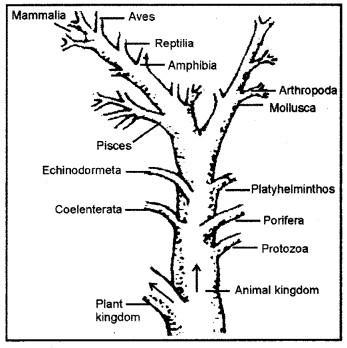
Question 2.
What are Vestigial organs? Write the name of some vestigial organs. What evidence does vestigial organs show about evolution?
Answer:
Some organs are found in animals today which are present in the form of remains. But they were highly developed and functional in their ancestors. Examples are as follows:
| S.No. | Animals | Vestigial organs |
| 1. | Human | Muscles ear, nictating membrane, coudal vertebrae, Vermiform oppendix |
| 2. | Marine bottom fish | less developed eyes |
| 3. | pythons (snake) | Vestiges of the hind limbs |
| 4. | Kiwi and Ostrich | Wings |
Question 3.
How geographical distribution of organisms support organic evolution?
Answer:
Evidences from Geographical distribution: Now a days, variations are found in the geographical distribution of plants and animals. For example, Platypus. Kangaroo and Eucalyptus plant is found in Australia only. Similarly, Giraffe is found only in Africa. According to scientists at a time, the continents were connected to each other. Later on they were separated by the sea. That’s why animals and plants found in one continent could not reach to another continent Due to different circumstances structures of them are changed according to different places. The geographical distribution is therefore also certifies organic evolution.
Question 4.
Describe Theory of inheritance of acquired traits of Lamarck. Also explain limitations of this theory.
Answer:
This theory was given by Jean Baptiste Lamarck in 1809. His theory is known as Theory of Acquired traits. According to Lamarck due to changes in environment, more frequently used organ strengthened and organ that was less frequently used disappeared. Giraffes are found in Africa. It has long legs and neck. It lives by eating the leaves of tall trees. According to Lamarck ancestors of giraffe were not so tall. They could easily eat weeds. Gradually, due to changes in the environment, desert extended and grassland perished.
To get the leaves of the tress which were at height, legs and neck had to use more frequently. That’s why its legs and neck become too long. These traits are inherited from generation and generation. Snakes live in holes. Due to inconvenience legs were use less and gradually disappeared. Drawbacks of Lamarck: Some scientists denied the theory of Lamarck. They said,”if the tail of a mouse is cut generation to generation, there is no chance of birth of a mouse with out tail. In the same manner, girls do not take with a prick in their earlobe even after girls are having it from generations.
Question 5.
What is the theory of Mutation? Explain reasons and means of Mutation.
Answer:
Theory of Mutation: Hugo de Vries gave the theory of mutation. When he tested some plant, he found that some of the plants produced are quite different from their species. These traits are inherited from generation to generation. These sudden variations in inherited characters are called Mutation. Mutation in animals can be caused by the following:
- Change in number of genes
- Change in gene arrangement
- Change in gene structure.
Means of mutation: Mustard gas, Nitrous acid, Phenol, X – rays, Beta rays etc.
Question 6.
Write a short note on Birbal Sahni with explaining his contribution?
Answer:
Palaeobotanist who enchanted the world with interesting tidbits, Birbal Sahni was bom on November 14, 1891 at Bhera village, in the Shahpur District. He is the founder of Palaeobotanical research in India. Among st a large number of fossil plants described by him from Rajmahal Hills of Bihar, was his most remarkable discovery of a new group of fossils Gymnosperms, to which he gave the name ” Pentoxylae”. Sahni was greatly interested in archaeology and he published a number of papers in this filed. His work “on the Technique of Casting coins in the ancient India” set a new standard in archaeological research in India. He founded the institute of Paleobotany at Lucknow, which was later renamed as Birbal Sahni Institute of Paleobotany after his death.
We hope the RBSE Solutions for Class 8 Science Chapter 7 Organic Evolution will help you. If you have any query regarding Rajasthan Board RBSE Class 8 Science Chapter 7 Organic Evolution, drop a comment below and we will get back to you at the earliest